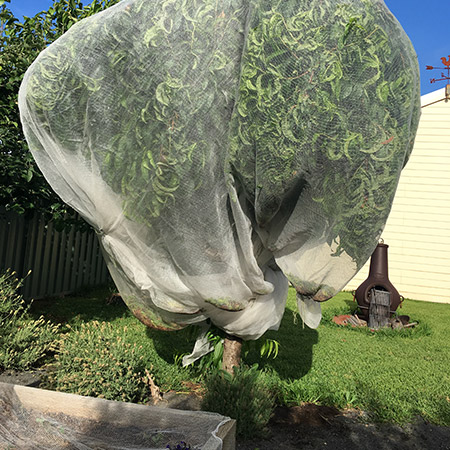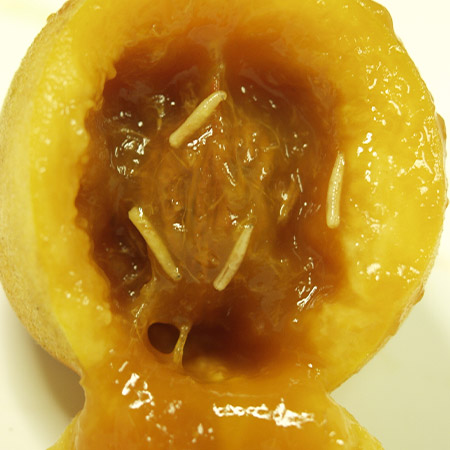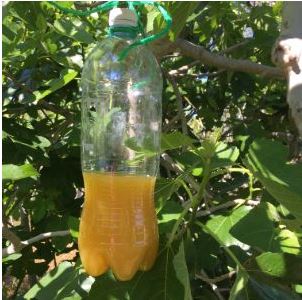Controlling Queensland fruit fly in home gardens
Advice on managing Queensland fruit fly in gardens is available in languages other than English.
Find out moreQueensland fruit fly is a serious pest for both home gardeners and commercial growers and found throughout Victoria. Home gardeners do not need to report Queensland fruit fly in Victoria. Queensland fruit fly attacks a wide range of fruits and fruiting vegetables, leaving them inedible. A list of common fruits identified as fruit fly hosts can be found on the Queensland fruit fly host fruits page.
You can manage Queensland fruit fly by monitoring its activity and by using a range of control methods explained below.
Watch this video to learn about:
- the life cycle of Queensland fruit fly
- how it spreads
- how to monitor fruit and vegetables for signs of infestation and control numbers.
[Narrator] Queensland fruit fly can be a problem for home gardeners and commercial growers because it attacks a large variety of fruit and vegetables, making them inedible. Queensland fruit fly spreads from infested plants to nearby fruit and vegetables, and by people sharing or travelling with home grown fruit or vegetables. While fruit and vegetables may look fine from the outside, they may be rotten or have eggs or maggots hidden inside.
So what do Queensland fruit flies look like? Adult flies are approximately seven millimetres long and are reddish-brown in colour, with distinct yellow markings. Queensland fruit fly goes through four main stages of life.
The adult female Queensland fruit fly injects her eggs into host fruit, laying up to 100 eggs a day. Eggs are white and one millimetre long, which makes them hard to see. You may see tiny puncture marks in fruit.
The eggs hatch into creamy yellow maggots that grow up to nine millimetres long. The maggots feed on the fruit, eventually chewing their way out. The maggots then burrow into the ground and change into oval, brown, hard pupae. After a few weeks, if conditions are suitable, the fruit flies come out of the ground and look for food around gardens.
After feeding and mating, females search for suitable ripe fruit to lay their eggs into, and their cycle continues.
So, if you want to grow fruit and vegetables in your garden, check for Queensland fruit fly and take steps to manage it before it spoils your produce or spreads to other properties.
So, to protect your garden, hang traps to monitor and catch Queensland fruit flies, apply baits and cover sprays to control Queensland fruit flies, pick up and dispose of fallen fruit, remove unwanted fruiting trees and vegetables, and net host fruit and vegetable plants.
Understanding Queensland fruit fly activity
Queensland fruit fly populations usually increase in spring as temperatures rise, but they can remain active in autumn and winter if warm weather persists and suitable host produce is available.
Queensland fruit fly are known to survive cold winters by taking refuge in sheltered areas. Queensland fruit flies can continue through their life cycle if the weather is warm enough and suitable hosts are available.
 Protect your produce
Protect your produce
Using insect netting is the best way to prevent female Queensland fruit fly laying eggs inside your fruit and vegetables.
- Insect-proof netting – drape fine, UV stable mesh over trees or frames made from PVC tubes or stakes to protect fruit after pollination has occurred. Secure nets around the base of the trunk (best if you have had Queensland fruit fly before) or to the ground to prevent flies from getting inside. Any fruit touching the netting may be stung by Queensland fruit fly, so it’s important to avoid direct contact between the netting and the fruit..
- Bags and sleeves – when fruit have set, place bags or sleeves over the fruit you want to keep. Secure them to the plant using tie wire, clothes pegs or string, ensuring there are no gaps where Queensland fruit fly can enter.
- Outdoor gazebo with zippers – cover plants with an outdoor gazebo with zippers, which allow easier access to fruit.
These products can be purchased from nurseries, home garden and online retailers.
For more information on how to use netting to protect your garden beds from pests, watch Gardening Australia’s short video.
Practise good garden hygiene
To reduce the risk of attracting Queensland fruit fly to your garden:
- Keep your garden free from unwanted, fallen and rotten fruit to remove potential breeding spots.
- Pick and use fruit or vegetables as they ripen or harvest the produce early if it will ripen after it's picked.
- Choose dwarf varieties of fruit trees which are easier to cover with netting and to inspect for damage.
- Reduce the size your trees so they don't produce more fruit than you need.
- Remove any unwanted or neglected host trees and replace them with early-maturing host plants or non-host alternative plants such as local wattles or grevilleas.
Dispose of unwanted produce properly 
Don't put untreated produce in your compost or worm farm because Queensland fruit fly will thrive under the warm and damp conditions and emerge as adults.
To stop the life cycle of Queensland fruit fly and prevent spread to other areas:
- microwave or boil unwanted fruit or vegetables to kill any maggots or seal fruit inside a plastic bag and place it in a freezer for two days until frozen solid.
- for large quantities of fruit, seal fruit or vegetables inside two garbage bags and leave in the sun for at least 14 days.
You can then discard the bagged, treated fruit or vegetables in your rubbish bin. Bagged fruit should not go into green waste bins because plastic is not acceptable in most green waste systems and to prevent any risk of live fruit fly going into green waste systems.
 Monitor your garden for fly activity
Monitor your garden for fly activity
Monitor your garden for Queensland fruit fly activity by:
- Installing traps to monitor Queensland fruit fly activity in your garden (see ‘Traps’ below)
- Regularly inspecting ripening fruit and vegetables for signs of Queensland fruit fly. Fruit infested with Queensland fruit fly can appear in good condition from the outside. Look for sting marks on skins and cut open fruit and vegetables to check inside for maggots.
If you notice fruit flies, or Queensland fruit fly eggs or maggots, you'll know that you need to act fast to control them.
Controlling Queensland fruit fly
Traps
Traps can be used to monitor and reduce adult Queensland fruit fly numbers. Traps used for monitoring are referred to as ‘male only’ traps.
If you have Queensland fruit fly in your garden, use a trap that catches both female and male flies. These traps contain a protein to lure Queensland fruit flies into the trap, where they are killed using an insecticide or liquid.
Hang traps approximately 1.5 m high, inside the foliage of a tree where QFF are likely to be (i.e. warm, shady spot out of direct sunlight).
Remember to refresh lures/attractants inside the trap according to their label directions.
Traps alone are unlikely to manage QFF — use a combination of control methods to manage QFF in your garden. One female can lay hundreds of eggs and damage your crop even if you have traps in your garden.
Queensland fruit fly traps can be purchased from nurseries, home garden and online retailers.
Make your own Queensland fruit fly traps
You can make your own traps using an empty soft-drink bottle and lid and homemade bait. Note that these traps can also attract insects that are good for your garden.
- In an empty soft-drink bottle, cut three holes about the size of a 10-cent piece, 10cm from the top.
- Add the bait mixture to the bottle. Pour in 1 cup of 100 per cent fruit juice (including pulp) and 1 tablespoon of cloudy ammonia (or wheelie bin cleaner).
- Tie a string around the neck of the bottle and hang it from the tree in the shade, 1m to 1.5m off the ground.
The mixture can last up to 3 weeks, but should be changed weekly for best results.
Baiting and insecticides
Bait sprays or gels combine a Queensland fruit fly food attractant with an insecticide to attract and kill Queensland fruit fly. Baits are usually spot-sprayed onto the trunk and foliage of host plants (not the fruit).
Adult Queensland fruit flies are attracted to the bait as a food source and are killed by eating the insecticide. Always read and follow the product’s label instructions as different baits have different application directions.
Insecticides are generally sprayed onto foliage and developing fruit to kill QFF on contact. Insecticide sprays can be harmful if used incorrectly, so always read the and follow the label directions. Make sure the withholding period has passed before picking treated fruit or vegetables and be sure to wash produce them well before eating them. Insecticides can kill non target species such as beneficial insects and spiders so always check the label.
Insecticide sprays can be harmful if used incorrectly, so always read the and follow the label directions. Make sure the withholding period has passed before picking treated fruit or vegetables and be sure to wash them well before eating them.
Neglected host trees and plants on public land
Report neglected host plants and trees on public land to the land manager (e.g. the local council), to encourage removal of these plants and trees, which will improve Queensland fruit fly management across your region.
Managing Queensland fruit fly in your garden resources
Download the 'Managing Queensland fruit fly in your home garden' fact sheet:
- Managing Queensland fruit fly in your home garden (PDF - 1.2 MB)
- Managing Queensland fruit fly in your home garden (WORD - 40.4 KB)
